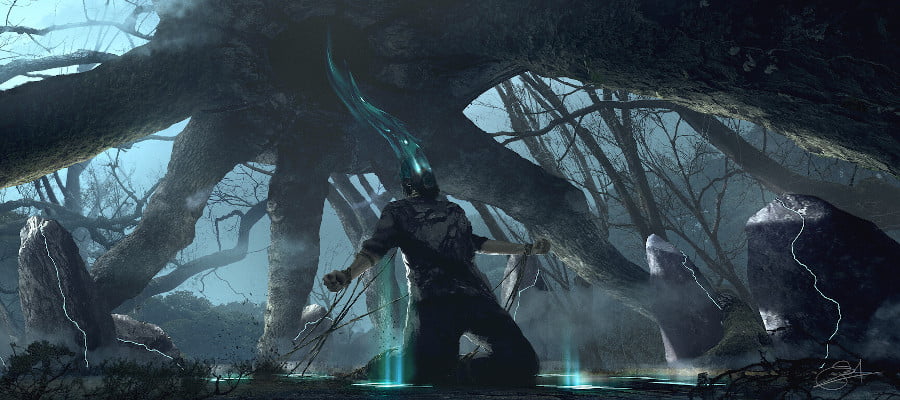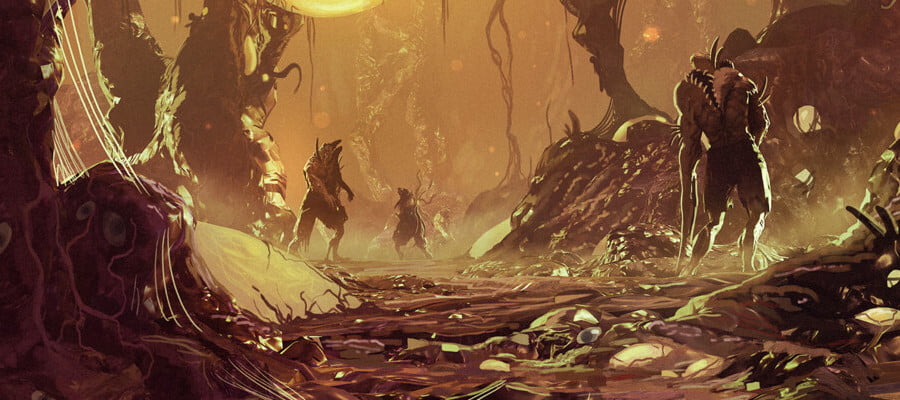I speak of Cobrin’Seil in terms of its people and their homes; this means that more often than not, I am talking about cultures and cities; so many features that are large and inexplicable are usually only mentioned when they are cities, like the Dragon Palace of Amenti. I sometimes feel that this means that the image of Cobrin’Seil, as a world, is that it’s a place where you spend your time engaging with civilisations, of negotiations between people, and it’s not really a space where you can just go out in the wilds and get into a fight.
On the one level, good. I don’t need a roaming empty wild space with dozens of underdeveloped weird humans like Bullywugs and Goblins and Frost Goblins and Bugbears and Hobgoblins and Orcs and Pistos and Half-Orcs and Gnolls and Greenscales and Kenkus and Shifters and Lizardfolks and Grimlocks and Orogs and Tannaruks to fill the world. I’d much rather make cultures that have a lot of variety rather than a few dozen things that are meant to be fully sentient humanoid creatures living their lives. Like, yeah, some of these exist, but they’re not the default thing you find when you wander off a path, just having a culture out there without ever being noticed.
This can create the feeling that out there, in the world, there’s just nothing you haven’t seen before in a city. That’s not true; setting aside that almost any given city doesn’t have the same people with the same reasons for being out there, there are also places with things out there, sites and zones that present mysteries.
For example, there’s a forest that’s slowly turning to meat.

Dal Raeda is a kingdom made out of provinces. Provinces are made to be important-sounding subdivisions of things that teetered on the edge of Being A Country before they had to Very Much Decide To Be Part Of A Country. It’s one of those terms that only exists because an existing power structure had to make a compromise between saying it’s the most important thing and not wanting to get murdered by a more important thing. Dal Raeda has had a very strong monarchy maintained through a number of infrastructural projects (woo we love infrastructure projects in this setting), but now the king is dead and suddenly the provinces are looking at themselves and considering two questions:
- Should our boss be the new king?
And more worryingly,
- Do we want a king? Including our boss?
This is because I want there to be an inherent tension, I want things to be leading up to an event but in that twilight situation where the players are able to feel like they’re stopping something vast from happening or they’re there when the rocks are falling and the pebbles can no longer vote. It also means that Dal Raeda (a very generic D&D kingdom) has this sudden, shocking snap into seven pieces where the cultures of these similar places get to be considered in light of their own, specific identities, and what cultural institutions spread across the provinces and don’t.
For example, there’s the Dal Raeda Historicians Society, which is basically a modern-day archaeological association who poke around in people’s back yards and have some vestiges of royal authority that let them inconvenience everyone who may want to be doing things like living their lives or stockpiling grain or putting out a windowbox or also marshalling armies in anticipation of a war for the succession of the throne of the entire nation. But that’s just one organisation that has authority across all the country, within each province, there are their own power bases.
One such province is Glotharen, which tends to be seen in terms of ‘sir not in competition for the throne.’ Glotharen is the oldest province, like, so old that the etymology of Glotharen is ‘named after Glotharen.’ It’s a place which lacks for major cities and industrial centres the way that the rest of Dal Raeda has, but that’s because the forests of Glotharen are protected by a handful of druidic traditions that have their own culture and alliances. Building a city takes resources like stone and wood and when there’s a druidic tradition that responds to clearing land with poisoned water supplies, you can be naturaly very cautious about it. The result is a province that’s very old, has ancient ruins and a lot of misunderstood places which are held the way they are out of habit, tradition and ritual. It is a place of mysteries and old forests.
And in amongst these forests, there’s a little valley, where the trees are made of meat.

The meat forest doesn’t have a name. Nobody’s claiming ownership over it; the druidic traditions around have a range of opinions:
- This is a corruption of nature, and we need to root out what’s causing it and kill it
- This is a new development of nature, and we need to take our time working out what that is
- This is something we definitely, definitely did and we’re sure we did and we’re sure we can do it against anywhere we want to, we just don’t want to right now, and our scrolls for it are in Canada
- Nature is providing meat for us to consume and it falls to us to fight this as part of the glorious struggle of death and life
- What we perceive is clearly not there because it’s nonsense, so this has to be a fey portal or something
- This is what life was before it became wood and it’s just something even older than we had
- I bet you can get some amazing drugs in there
Researching the meat forest has some challenges, not the least of which being that it will try and eat you. The ground is dangerous and there are treacherous life forms that are like things you already knew but made of teeth, and of course, no druidic order is actually recognised as responsible for it. Which means that everyone’s sending agents in to check it out and some of them come out and then they try and make sense of what they find.
The meat forest is old, of course; everything in Glotharen is, really. But the oldness of it is why most druidic orders assume they know what it is (and who’s in charge of it), but similarly the rising tensions across Dal Raeda are why everyone’s inspecting it now. After all, it’s something that’s clearly dangerous, what with the way it can put blood in pollen and fill people’s lungs with it, but nobody knows what’s doing with it.
As a DM and storyteller, I don’t have an explanation for the Meat Forest and have to actively resist explaining it. It’s important to me to be clear what this tumourous place isn’t, what it’s not drawing from. This isn’t SCP-610, the Flesh That Hates. I know, I know, considering that that’s literally the art I used. The Flesh That Hates is meant to be one of many apocalyptic clocks in the SCP setting, and it’s meant to be something that will come to pass soon-ish, as one of many schemes enacted by an evil cult that worship a god of flesh (unless that’s been written out because of the author’s problems). That’s fine, it has an agency and a start, but it’s still an explanation, it’s a horror-movie escalated version of a real thing like Agent Orange or weaponised Anthrax.
It’s also not Xoriat, the plane of meat from Eberron, run by the weirdo meat people who use meat for everything. That creates a feeling of agency and also an explanation that shifts the focus. It’s not ‘why is there a meat forest where the leaves are tongues and everything is audibly exhaling,’ it’s ‘why did the Xoriat put this thing here.’
It’s not meant to be a thing to be solved. Having an answer for it means that any given player going there is going to be seeing it in light of potentially discovering a reason, a why, and that can dilute the horror of what it is. There’s threat to your survival if you’re there, yes, but the driving agents around it are, once again, cultures and cities, and how people react to this strange thing in the wilderness that can be made dangerous.